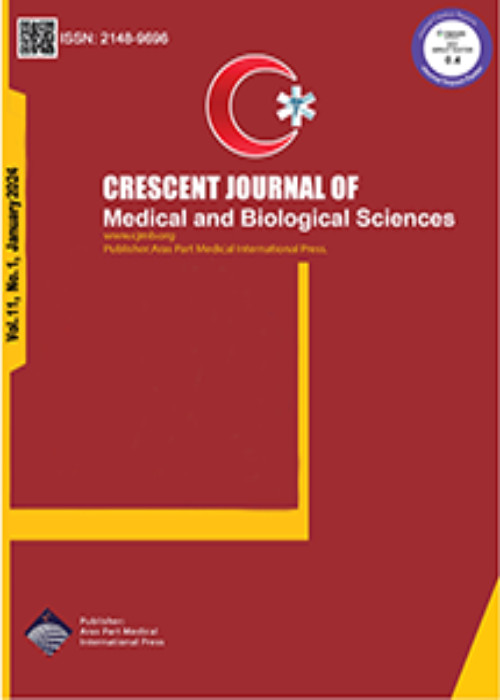فهرست مطالب

Crescent Journal of Medical and Biological Sciences
Volume:3 Issue: 1, Jan 2016
- تاریخ انتشار: 1394/10/17
- تعداد عناوین: 8
-
-
Page 1ObjectiveBasil herb (Ocimum basilicum) has long been used in human nutrition. Nowadays antioxidant role of this herb is known more. The aim of this study was to study the anti-oxidative property of sweet basil to protect central nervous system against oxidative damages of electromagnetic field (EMF) and its affective sequences.Materials And MethodsForty Albino male Wistar rats were randomly allocated to four groups, 10 rats per each. Group 1 received normal diet (control group), group 2 was exposed to 50 Hz EMF for 8 weeks (EMF group). Group 3 was exposed to 50 Hz EMF and fed with basil extract (0.5 g/kg body weight) for 8 weeks (treatment group) and group 4 was fed with basil extract (0.5 g/kg body weight) for 8 weeks and named as herbal group. At the end of eighth week 5 mL blood was taken from all rats for biochemical analysis and for ultra structural study of brain neuron samples was taken.ResultsThe results showed level of superoxide dismutase (SOD), glutathione (GSH) peroxidase and catalase activity (CAT) were significantly increased in herbal and treatment groups as compared to EMF group (P < 0.05). Level of malondialdehyde (MDA) was significantly decreased in treatment group as compare to EMF group (P < 0.05). Ultra structural evaluation of EMF group showed brain nucleus has a lot of heterochromatic changes and mitochondria have been ovulated and have swelling figure this changes were less in treatment group.ConclusionAntioxidant capacity of basil extract can cause to decrease oxidative effects of EMF on brain tissue and in rats.Keywords: Brain, Neurons, Ocimum basilicum, Oxidative damage
-
Pages 8-13ObjectiveDue to the increased number of labour inductions in women with previous cesarean section, the risk of uterine rupture leading to maternal and fetal mortality is also increasing. In this manuscript, we aimed to review the risk of uterine rupture in labour induction of women with prior cesarean section.Materials And MethodsData from 48 reports belonging to the years 1994 through 2015, obtained via a search on various internet sources by the words “labour induction”, “previous cesarean”, “uterine scar”, “uterine rupture” were used to characterize the risk factors, methods and complications of labour induction in women with previous cesarean section.ResultsThe success of labour induction after a previous cesarean section is related to a history of prior vaginal delivery, the indication of prior cesarean delivery, age, body mass index and ethnicity. The risk of uterine rupture is lower with mechanical dilatators compared to prostaglandins when they are used for cervical ripening. Oxytocin is associated with an increased risk of uterine rupture in such women but induction and augmentation of labor is an option for all women undergoing a trial of labor after cesarean section. Although some guidelines discourage the use of prostaglandin E1, some others support the use of prostaglandin E1 or E2 for induction of labor in rare situations provided that the women be informed of the higher risk of uterine rupture.ConclusionsPrevious uterine surgery is the most common underlying reason for an increased risk of uterine rupture in subsequent trial of labour. When indicated, before considering a labour induction in these patients, a risk assessment should be performed based on various parameters. For prediction of uterine rupture, lower uterine segment may be measured by ultrasonography. Individually selected methods for labour induction should be discussed with the patients since they are mostly associated with increased risk of uterine rupture.Keywords: Uterine rupture, Labour induction, Pregnancy, Vaginal birth after cesarean
-
Pages 14-18ObjectiveThis study aims to investigate healthcare professionals’ (HCPs) general level of knowledge about sexually transmitted diseases, their attitudes towards these patients and legal aspects of medical services.Materials And MethodsThis was a multi-centered study. The participants were given 28 questions that mainly asked their level of knowledge on sexually transmitted diseases (STDs) patients, their attitudes towards such patients, and their legal as well as ethical views on them.ResultsA total of 234 HCPs, 124 (53%) female and 110 (47%) male, participated in the study. The majority of married HCPs have reported monogamy as the most reliable protection method, whereas single participants have marked “condoms.” The most commonly known STD has been reported as AIDS in all groups. Even though HCPs find it medically unethical not to offer a medical intervention to patients with STDs, more than one-third of the participants believe that HCPs should have the right not to do so.ConclusionIt has been concluded that HCPs need further education on STDs. Nevertheless, such high level of care and attention on HCPs’ part does not necessarily decrease their need for proper medico legal regulations on such issues.Keywords: HIV, positive persons, Sexually transmitted diseases, High, risk sexual behavior, Medical accidents, Medico, legal issues, Survey
-
Pages 19-22ObjectiveNinety percent of neonates pass the transition from fetal life to outside uterus successfully, and only 1% needs intensive support for survival. The quantity of oxygen saturation immediately after birth shows the need for resuscitation immediately after birth. The present research was carried out with the objective of comparing saturation rate of arterial blood hypoxia in neonates born with normal vaginal delivery and cesarean method.Materials And Methods220 neonates born with elective cesarean section and normal delivery were studied in an analytical-descriptive study. Demographic questionnaire was completed. Then a pulse oxymeter with its sensor fixed on the right wrist of the neonates was used. Heart rate was recorded and the level of oxygen saturation (SaO2) under 90% was considered as hypoxia. To compare the quantitative and qualitative variable between the two groups, paired t test and chi-square test was used, respectively. Pearson correlation test was used to study the correlation between the variables.ResultsThe age range of mothers was 16-38 years. The mothers’ average age, gestational age and neonates’ weight were not significantly different between groups. The average SaO2 in minutes 1, 3 and 5 was 72%, 81% and 89%, respectively in vaginal delivery, which showed a significant difference compared to cesarean neonates with average of 65%, 75% and 83%, respectively. No significant difference was observed after10 minutes. Also there were not significant statistical correlation between mothers age, number of pregnancies, sex and weight of neonate with SaO2 of arterial blood after 1, 3, 5 and 10 minutes after birth.ConclusionWith respect to the results of the present research SaO2 was higher in neonates of vaginal delivery in comparison to cesarean neonates. Encouraging mothers to delivery vaginally and also using aid-oxygen is proposed for the cesarean neonates at birth.Keywords: Cesarean, Delivery, Neonate, Oxygen saturation
-
Pages 23-27ObjectiveCoronary artery disease (CAD) is a leading cause of death of women and men worldwide. Endothelial dysfunction, smoker, diabetic, cell adhesion and oxidative stress may be considered as novel risk factors of CAD. These materials are cooperative events involved in atherosclerosis development. In the present study the serum levels of fibronectin, leptin and LDL-oxide were investigated in patients of CAD including non-smoker and non-diabetic with control group. Measurement of these parameters helps to prevent and treat the disease.Materials And MethodsIn this study we measured serum levels of fibronectin, leptin and LDL-oxide in 200 individuals including 100 patients with CAD and 100 individuals as control group. Also patients with malignancy, renal and liver diseases and other disease were excluded from the study. Serum leptin and fibronectin were measured by enzyme-linked immunosorbent assay (ELISA) method using kits from German Imediagnostic and Chinese Crystal Day companies, respectively. Moreover, ELISA procedures were used to determine the serum LDL-oxide.ResultsThe serum levels of fibronectin, leptin and LDL-oxide were increased significantly as compared to control group (P ≤ 0.05 in all cases). It seems that there was strong (+) correlation between fibronectin, leptin and LDL-oxide in CAD.ConclusionIt was concluded that endothelial dysfunction, cell adhesion and stress oxidative are cooperative events involved in atherosclerosis development. Fibronectin, leptin and LDL-oxide have become greatly important in pathogenesis of CAD. Association between fibronectin, leptin and stress oxidative suggest that their involvement in development of atherosclerosis can be used as detective measure.Keywords: Coronary artery disease, fibronectin, Leptin, LDL, oxide, Non, diabetic, Non, smoker
-
Pages 28-32ObjectiveCardiovascular disease (CVD) is a common cause of morbidity and mortality. The relationship between ABO blood groups and main risk factors of CVD is unknown. So this study was designed to investigate whether there is an association between ABO blood groups and cardiovascular risk factors in otherwise healthy people.Materials And MethodsIn this cross-sectional study, risk factors for CVD were screened in 300 patients with coronary artery disease (CAD) who were hospitalized in Madani hospital (biggest heart center in Tabriz) in 2013-2014 and evaluated by a questionnaire that aimed to extract information about age, sex, smoking, blood group type, weight, height, blood pressure, diabetes mellitus and family history of CVD. Data were analyzed with SPSS 17.ResultsOf the total selected 300 patients, 69.3% were male, 35.3% were smoker, 61% were hypertensive, 30.3% were diabetic mellitus, 31% had hyperlipidemia, 70.97% were obese and 17.3% had family history of CVD. The mean age was 62.06 ± 11.40 years. Blood groups O (28%), A (43.3%), B (19%) and AB (7.3%) were the most frequent ones, respectively. According to our results, we found that the rate of CAD in individuals with the blood group A was higher than the other blood groups. Regarding the risk factors, however, no significant difference was observed between the blood groups.ConclusionA correlation was found between blood group A and the incidence of CAD and there was no significant difference between the blood groups and cardiovascular risk factors and number of involved coronary arteries.Keywords: ABO blood, group system, Cardiovascular diseases, Risk factors
-
Pages 33-34IntroductionCardiac tumors can be divided to primary and secondary and to benign and malignant tumors. One of the benign tumors of the heart is cardiac fibroma. More than 80% of this tumor occurs in children; however its occurrence in neonates is very rare. Fewer than 100 cases have been reported.Case PresentationOur patient is a 10 day’s girl neonate with severe dyspnea, mild cyanosis, tachycardia (heart rate = 170- 180/min) and obstruction of right ventricle (RV) outlet with very large tumor.ConclusionCardiac tumors in neonate population must be considered in the diagnosis of arrhythmias, cardiac insufficiency, valvular disease, cardiomegaly or presence of murmurs. Early diagnosis before birth should be appropriate and accurate imaging devices must be used in detecting these tumors.Keywords: Dyspnea, Fibroma, Neoplasms, Newborn, Tachycardia
-
Pages 35-36Brucellosis is as one of the most important infection common disease between human and cattle, which nowadays considered as one of serious health systems dilemma specifically in developing countries.Among brucellosis different species are the cause of infection, 4 species namely B.melitensis, BSuis, B.abortus, B.canis are the most major cause of disease in human(1).Indeed, in Iran that is considered as an endemic area of hygienic organization, B. melitensis is as the most prevalent cause of infection in human. This bacterium generally will transfer to human from contact with contaminated animals or the consumption of cattle production such as unpasteurized dairy (raw milk, soft cheese, cream) or even via breathe can transfer to human. But the transfer of infection from person to person is very infrequent.Of course there is some evidence of transfer in a bone marrow transplanting. The most prevalent clinical symptoms of this disease are fever, night sweat, asthenia and anorexia (2).Naturally this infection involved different systems and organs in human body and the one of most major part of body can be mentioned to nervous system, muscuskeletal and also some organs like joints, heart and liver.Diagnosis of this infection can be made by some various laboratory tests like SAT, 2ME. But some misdiagnosis instances are very common. Thus, World Health Organization (WHO) exposed in its report that the number of infected cases are maybe ten folds more than scale which stated by health organizations.


